
Location: Yeppoon, QLD
Established: 1992
Architect: Karl Litten
First Played: 9th Dec 2016
Last Played: 9th Dec 2016
Magazine Ratings

58 (2018)

91 (2014)

79 (2019)
The last really remote location on my Top 100 golf journey was to Capricorn Resort Golf Course, located in North Queensland. An area more well known for the Great Barrier Reef located offshore, this little gem was a trip to the tropics.

Capricorn Resort Golf Course Entrance
Originally opened as a golf resort, with two courses, the Championship course and the resort course, hard times have hit. The resort course closed just over twelve months ago, then the resort itself closing its doors mid year, with only the Championship course remaining. Setting off a panic alert, I was determined to get in a game before this course also potentially closed (to clarify there is no word of this happening). Failure to do so would see completion of lists from 2012 to 2016 be impossible.
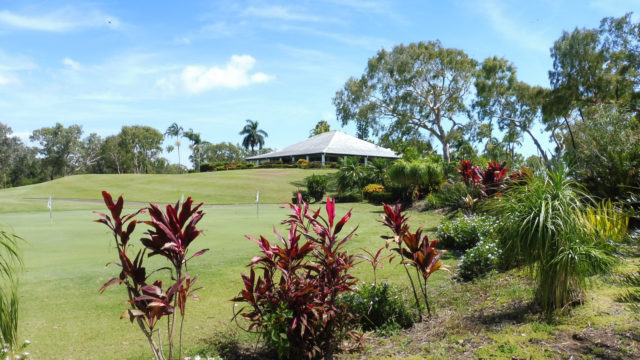
Clubhouse at Capricorn Resort Golf Course
Built on the highest point of the course, the clubhouse overlooks four holes. With a large outdoor area, those that enjoy the heat and humidity can sit outside and take in the ambiance. For me, air conditioning will do just fine inside thank you very much.

Capricorn Resort Golf Course Map
Spread out over two loops of nine, the course routes its way around a water body in the middle of the property.

Scorecard for Capricorn Resort Golf Course
Play on the day was from a mixture of the blue and white tees. One thing to note is all measurements on the course are generally in yards, which is quite unusual for an Australian course. Something I didn’t really take note of until after the round. Explained why some of the danger came into play, when I thought a shot was being left safely laid back.

Hole 1 – 526 meter par 5
Starting the round is the longest hole and hardest par 5 on course. The hole predominantly turns to the right with trees running either side. From the tee it appears quite narrow, especially with one tree protruding greatly on the right. Mounding either side from the tee assists in bringing the ball to the fairway, however staying to the left the whole length of the hole is ideal to allow a clearer shot.

Looking back from the 1st Green
Being either well back or left is critical for the approach, with a tree located on the right of the fairway, blocking most shots. It isn’t until reaching the green complex that the first bunkers are encountered, three in fact with two located at front, leaving a small opening to the green. Whilst another sits at the rear built into a large mound. A tough way to start the round, which will play as a true three shot hole. Unusual with two trees being found on the right side of the fairway, limiting the lines to be taken.

Hole 2 – 381 meter par 4
Things don’t get any easier with the longest and hardest par 4 next up. Playing again with a dogleg right one thing becomes more apparent. Larger trees are found closer to the fairway, spread out however, with open areas beneath, allowing some sort of recovery shot. This is followed a few meters back with denser scrub, where finding a ball becomes less likely. Longer hitters will be able to cut the corner if they have a high ball flight, otherwise play needs to be around the trees.

View from behind the 2nd green
Again trees encroach on the right, leaving the left side of the fairway ideal for the approach. With no bunkers located on this hole, the green is surrounded with a few mounds and swales. The putting surface is quite long but has two distinctive tiers. For the length of the hole, the approach seems quite narrow with trees blocking the right side, but has a good testing green.

Hole 3 – 155 meter par 3
After a tough start some relief is found with the equal shortest hole on the course (along with the 11th). Playing over relatively flat ground, the green appears at the same height as the tee. An accurate shot is required to hit the green with seven bunkers on its surrounds. Ample room is found short, for those not confident enough to reach the target.

Bunkers surround the 3rd green
Four of these, quite small, are located spread out evenly along the front. Small gaps are left between, but anyone wanting to run the ball in needs to be extremely accurate. The remaining three are much larger placed along the rear section of the green complex, the further most built into a large mound. Not the most exciting of terrain but a challenging hole, which has quite a bit of forgiveness in certain areas.

Hole 4 – 379 meter par 4
Heading out into what could be termed a more open area of the course, is this longer par 4. Playing from a slightly elevated tee, this hole plays relatively straight, but has a forced water carry starting at around 200 meters from the tee. There is ample room to land the tee shot, with center to right leaving a better line.

Forced carry over the hazard on the 4th fairway
The approach must be made uphill to a green guarded on either side by a trap. These are set slightly forward but leave a clear entrance to the green. The surrounds have a few meters of shorter grass before finding some longer rough.
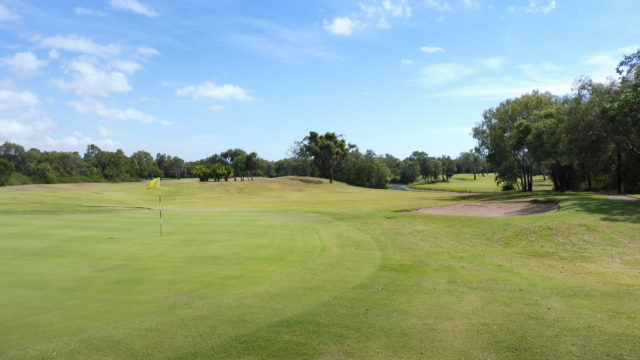
Looking back from the 4th green
From the tee, it looks an interesting hole. I’m not usually a fan of forced carries, especially when they fail to offer risk or reward. With the distance from the tee, the water hazard really isn’t an option to carry, so it is a case of selecting the correct club to avoid a wet ending.

Hole 5 – 368 meter par 4
Heading off to the north east is this mid length par 4, with a dogleg to the left. Mounds are found out on the right of the turn, which slightly assist in showing the direction of the hole. Longer drivers have a chance of finding the bunker at the end of the corner, leaving a difficult approach. Ideally playing to the left portion just beyond the corner will leave the best angle to the green.

Approach to the 5th green
Selecting the correct club, will need to be considered with the approach, as it is up a slight slope. Six bunkers are found around the green, one with a tree growing in the face (not the first you will come across with a tree). The green rises slightly at the front, but will still allow an approach to be run in, whilst the putting surface predominantly runs from the rear to front. A more traditional style hole which offers some strategy. It’s easy to blast away finding any portion of the fairway from the tee, but finding the left side will lead to an easier second shot.
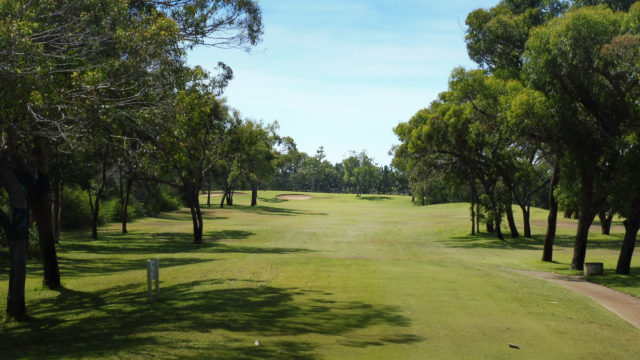
Hole 6 – 317 meter par 4
The shortest par 4 on the course is another dogleg to the left. From the tee, play is through a narrow chute, however this opens up dramatically to the right at the turn. There will be temptation for longer hitters to cut the corner trees, but playing too long with bring a large mound, beyond the fairway, also containing a couple of bunkers, into play. This separate the 6th and 4th holes.

Large humps beside the 6th green
For the ideal clear line into the green, finding the center of the fairway would be a good choice. Too far left or right, bring trees into play on either side. The green sits slightly elevated, with numerous mounds around its edges. The putting surface here sees sloping predominantly from the right. A hole which offers some risk vs reward from the tee. Also trees are used deceptively to hide the room available on the fairway. Not a perfect hole, but an interesting one.

Hole 7 – 166 meter par 3
From the shortest par 4 we come to the longest and easiest par 3. Interestingly this when played from the back tees, this actually becomes the shortest par 3 on the course. Play is around/over a water hazard, before a large section of land opens up before the green. Anything sligthly mishit has a good chance of finding the water, due to sloping on its surrounds.

Long sloping 7th green
With a long green angling slightly away to the left, it is quite narrow at its front, expanding towards the rear. Alongside to the left is a large bunker. This almost feels like being in an amphitheater with trees all around, but luckily they are far enough back to only catch a wildly hit shot. Not the most exciting par 3 on the course, but certainly challenging.
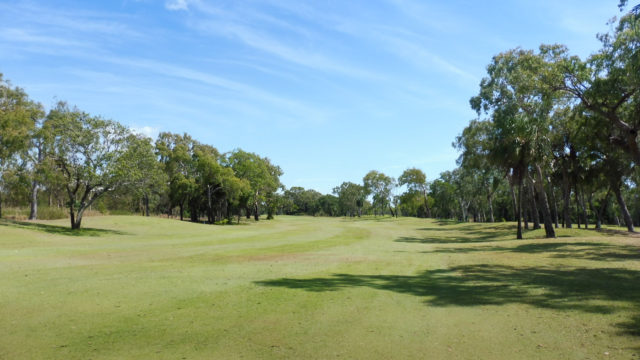
Hole 8 – 334 meter par 4
Starting the trek back towards the clubhouse is this shortish par 4 which turns gradually to the left. Like the first two holes, trees line either side of the fairway, but these seem just a little closer. Finding the center to right of the fairway allows a clear shot in.
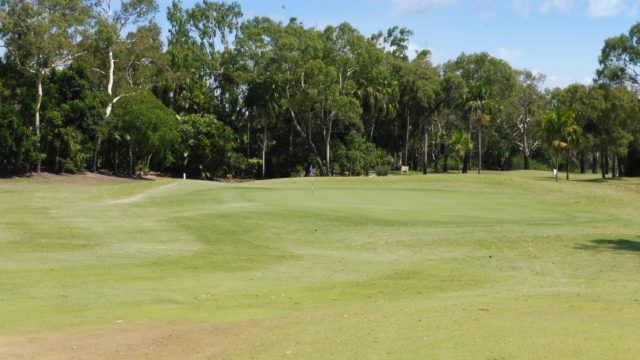
Bunkerless 8th green
Making the approach to a wide open green, I first notice the lack of bunkers (this is the first of three holes without sand in play). The front and left sides are slightly elevated, whilst the remaining sides contain small mounds. Finding yourself on the left will open up a variety of shots, depending on the pin position. Looks a simple hole, but finding yourself out of position will make this a lot more difficult than it needs to be.

Hole 9 – 498 meter par 5
Finishing the first loop is a long par 5 which plays relatively straight. Heavily tree lined on either side, there are also isolated trees further towards the fairway, scattered at various points. The odd hump or mound is found either side, otherwise the fairway remains fairly flat. Off the tee there is a bit of space to land the drive, but this quickly starts to disappear, leaving a decision on where to land the second.

Clubhouse in view behind the 9th green
The green angles away to the left, with one trap sitting at the front. Slightly elevated at the front, this increases the further you move back, leaving a large fall away at the rear.

Looking back over the 9th hole
With such a narrow fairway this hole is more about accuracy than any real strategy, although a decision is required on how far to hit the second shot, staying back from encroaching trees or flirt with danger to leave a short third.
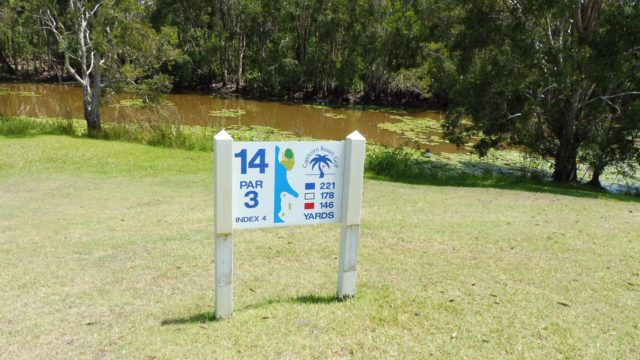

Hole marker and other signs
For each hole the marker includes the usual but also a map. This is always useful for first time play. It looks like potential advertising was found on each hole marker, but have since been removed. Pin flags were plain but had different colours depending on pin position on the green. Where a blind shot to a water hazard was approaching, signs were given on distance to the water.

Hole 10 – 370 meter par 4
Starting the second loop is a mid length par 4 which doglegs to the left. From the tee the landing area looks smaller that what is actually available. Bunkers are found through the fairway, whilst trees are scattered along the sides. Hugging the left side of the fairway will allow the best approach.

Looking over at the 10th green
One large bunker is found short on the right, whilst a smaller one is located on the left of this long green. Hole where accuracy is key.

Hole 11 – 155 meter par 3
Coming to the equal shortest hole on the course, although this does play shorter than the given distance, is a par 3 playing from an elevated tee. This is the signature hole at Capricorn Resort, playing down to a green with water in front. For those not confident, a stretch of fairway runs down the left with two traps built into the waters edge, allowing a dry path to the green.

Shot if you plunked one in the water – 11th dropzone
Those taking on the challenge will find a green with two tiers, the right side lower than the left. Finding the middle of the green will see the ball run to the bottom section of the green. One of the standout holes on the day. This is a really well designed hole, giving a safe option for those not capable of carrying the distance, also a forward tee was built leaving a shot only over land to the green (good for those new to the sport). Those playing to the green have to play to the correct portion, otherwise a difficult putt may be faced.
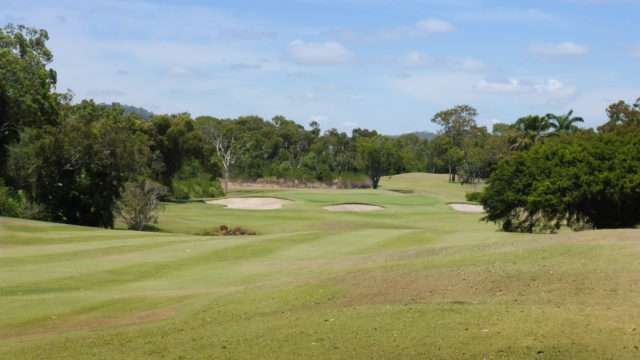
Hole 12 – 326 meter par 4
The first of two similar distance holes, is the easiest on the course. With a wide fairway, mounds to the right, will assist in feeding balls back to the short grass. Unseen over a small dip in the fairway is a forced water carry. Without looking at the warning sign on distance to the water, or the map, this is easily reached. After hitting a great tee shot I almost found myself in this. I was a bit puzzled at the time on how I had hit the ball so far with my 3 wood, until after the round, with the discovery of all distances being in yards.

Another forced carry to the 12th green
Again this really is not a hazard which will be carried from the tee, so it is about laying up to a comfortable distance. Three bunkers are found along the front and sides of the green, so there is no ideal angle for the approach. A strong slope on the putting surface, from the rear to front is found, so leaving the shot under the hole is critical. I enjoyed the hole, but think this could be so much better with the tees further forward, shortening the hole, really making it a risk reward shot from the tee.
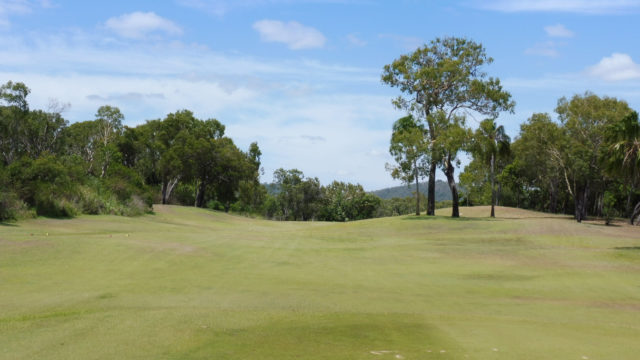
Hole 13 – 325 meter par 4
The next hole measures similar in distance, but would play slightly shorter due to the elevation changes. From the tee play is through a saddle, but it becomes obvious something doesn’t look quite right. That would be the large tree sitting on the right edge of the fairway, reducing the potential space for the landing the ball. Once over the rise the fairway falls away quite dramatically before reaching a water hazard.

View from the elevated 13th fairway
For the approach, a shot from an elevated position, water must be carried to reach the green. This actually runs from the front, around the left then rear. Ideally from the tee, finding the left portion of the fairway allows for an easier approach. Again on the right are tall trees (palms this time) which need to be carried to reach the green. Four traps are found along the front and left section of the green complex. I really enjoyed this hole, but the clump of trees to the right of the fairway for the tee shot should be removed. This restricts the use of the landing area on the fairway, in particular the right portion. Not sure if they are in play for safety or reducing the chances of people playing too far right, but think there would be benefit from their removal, or pruning at least.

Hole 14 – 163 meter par 3
After reaching the furthest point from the clubhouse, we start our journey back with the hardest par 3 on the course. This requires a carry over the water hazard, located just short of the green. If playing from the back tees, this becomes the longest par 3.

Looking over at the 14th green
A small portion of fairway is found short of the green, which has two traps on either side at the front. Angling away to the right, the green has a false front, with mounding at the rear. This is all about the carry over the water. There is no way around it. Tough hole which deserves respect.

Hole 15 – 444 meter par 5
Interestingly the next hole is the shortest and easiest par 5. Meandering its way along a water body to the left, from the tee a small portion must be carried to reach the fairway. A small group of trees are located to the left and best avoided, with adequate room for the tee shot. The more aggressive line is around the trees, which brings the first of many bunkers into play. In fact along the fairway to the green there is no less than 15 to contend with, most being on the left side of the fairway.

Well bunkered 15th fairway
As with most long holes, the fairway narrows the closer you get to the green. Trees are found either side just short of this, which is found at the top of a small steady rise in the fairway.

Looking back from the 15th green
So why is this hole so interesting, well because it was the most enjoyable par 5 on the course. Even though the shortest and easiest, it still had a lot of risk verse reward with the shots. Thought had to be given for each shot. Was it overkill on the number of bunkers, probably, but this only added to its character.
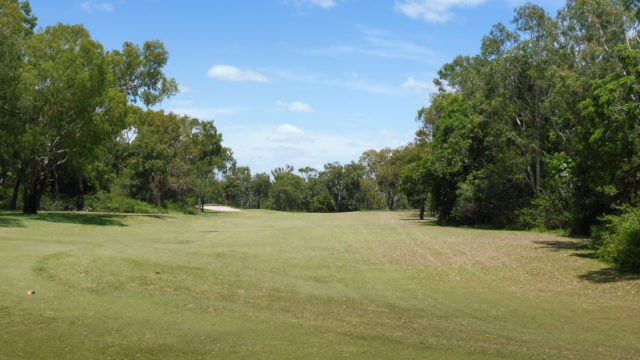
Hole 16 – 325 meter par 4
Playing out to another corner on the course, is this shorter par 4, which turns to the right. Visually this is quite a tight hole from the tee. In fact without seeing the map it is hard to tell which direction the hole plays. On the outside of the corner is a bunker. Longer hitters may carry the trees to the right, shortening the approach, but there isn’t a lot of fairway to land the ball.
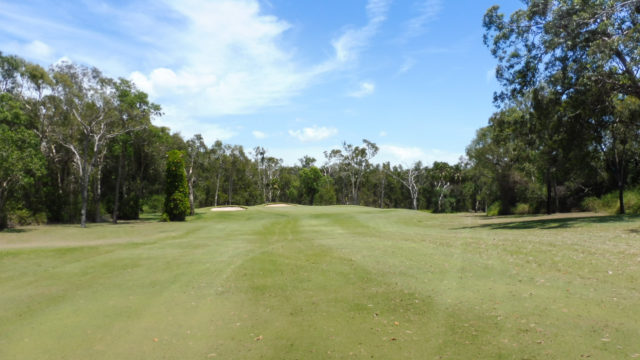
Approach from the 16th fairway
It is critical to pass the trees at the corner of the turn, to allow an clear approach. Ideally the center or left of the fairway is the best angle. Bunkers are located to the left and rear of the green, but a probably more in play for those approaching from the right. After so many holes turning to the left, it was a bit of an adjustment, playing in the other direction. Not a hole which sets the world on fire, playing into an afternoon setting sun and quite a narrow fairway to contend with.

Hole 17 – 343 meter par 4
The penultimate hole is a mid length par 4 which turns to the (you guessed it) left. Water runs along this side all the way to the green. Trees do not heavily line both sides, giving the impression of a lot more space. For the perfect line, play is down the left, just inside the tree line, leaving it in the center of the fairway beyond the turn.

Dogleg on the 17th fairway
Sitting slightly behind the water, the green complex is no easy target. Some forgiveness is allowed out to the right, but anything too far left is wet.

Lizard on the 17th green
A large goanna was basking on the green near the pin (look at the black line near the flag). Lucky for him he was safe being so close, although I was worried he might run off with my ball thinking it was an egg.

Last look from the 17th green
Three bunkers are located at the rear of the green, built into a small mound. I often question bunkers at the rear of a green with how often they see play. An enjoyable hole, although could be quite penal if off line.
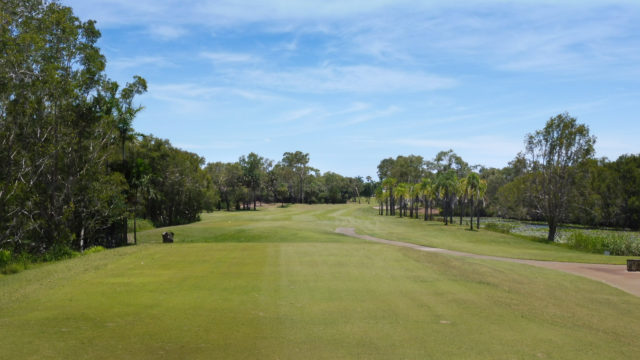
Hole 18 – 459 meter par 5
Finishing the round is a mid length par 5 which plays with a slight curve to the right. From the tee water is found on the right, but shouldn’t come into play. The fairway is quite adequate, although it does narrow as a rise in the fairway starts.
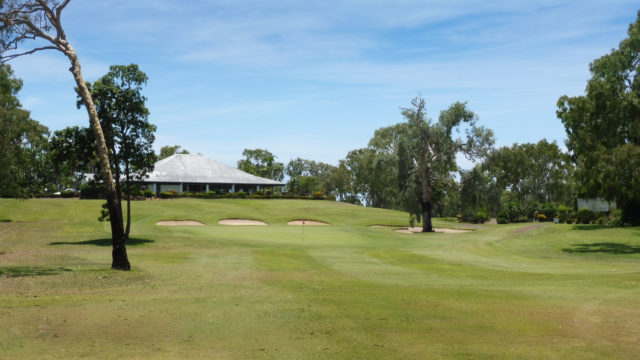
Approach to the 18th green
Again the fairway narrows considerably as we make our way to the green. Two sections of trees are found either side, the inner quite sparse allowing a ball to be found, whilst the outer has heavy scrub at their base. The putting surface here slopes considerably from the rear to front, with three traps to the rear and another on the right.
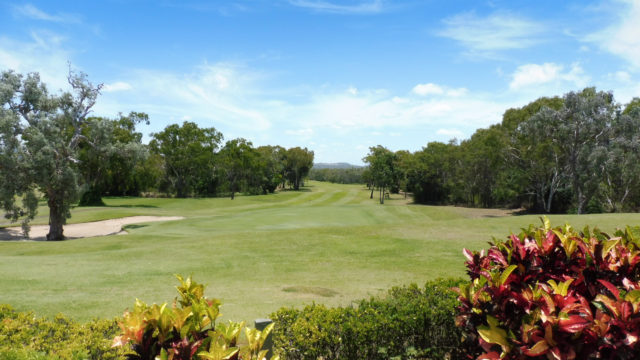
Clubhouse view of the 18th hole
This has a large tree located in its middle, so find yourself on the wrong side of this could be a nightmare. Not the best finishing hole I have ever come across. It has some slight elevation changes, but plays relatively straight with a narrow fairway towards the end. One positive is the scenic view of the clubhouse and a refreshing drink awaiting.
Looking at the course makeup:
- Hole Directions – There was a reasonable variety in hole directions, allowing for conditions to have wide ranging effects during play. There are however runs of holes in a similar direction 1-3, 8-9, 10-11 and 14-15. This can be frustrating, especially in into unfavourable conditions. Hole 16 has a westerly facing tee, which may have issues late in the afternoon with sun
- Hole Lengths – Par three holes had some variance in distance, all are mid length. There was only 11 meters separating the shortest to longest. A great variation was found with par four holes, ranging from short to long and quite evenly spread amongst these groups. There was a case of similar distance holes running consecutively though (12-13). Par 5 holes ranged from mid to long with the latter being the majority, evenly spread
- Hole Layout – There was a decent mixture in how the holes played, although an overwhelming majority tended to favour turns to the left, where two shots or more were required to reach the green. This outnumbered those turning to the right two to three

Panoramic view from the clubhouse
In summary, the course was enjoyable, but at times a little too tight for my liking. This limited some of the potential strategy that could be employed on the holes. The course certainly fit in with the area that surrounds it, feeling quite natural, which is always a positive.
Conditioning of the course could not be faulted. Generaly the tees and fairways were top quality. A few bare patches in places, but a high standard overall. The bunkers were quite consistent throughout the course and mostly well positioned. The green complexes were good, offering a variety of cut heights in grass, allowing for a variety of shots to be played. This was not always the case but overall could not be faulted.
Overall this was the course was fairly memorable. The standout holes were 4, 11, 15 & 17. Two further would be standouts for me with a few tweaks, 12 by bringing the tees forward to allow the possibility of carrying the hazard, whilst 13 could do with tree pruning with those on the fairway.
Would I return to play again? It wouldn’t be on my priority list, more due to location than anything else, but it is certainly worth at least one visit. It is quite out of the road and with the resort now closed, makes the task a little more difficult.
How to play at Capricorn Resort:
1. Public access is available 7 days a week

